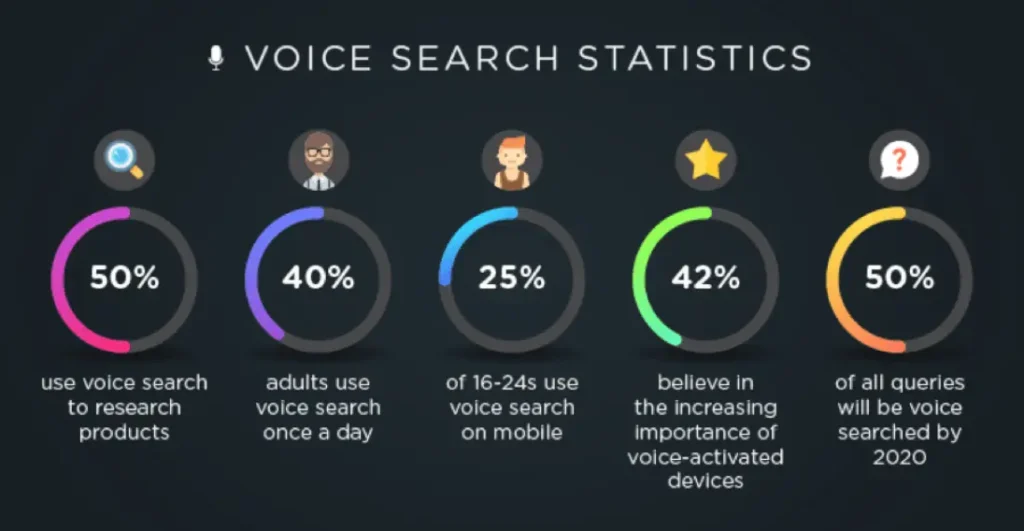Do you know that according to Digital Success, 22.8% of SEO professionals recognize voice search as the most notable emerging factor in SEO?
Your e-commerce business needs to implement voice search optimization on its website.
Voice search uses voice-activated technology, such as virtual assistants, Siri, Alexa, and Google Assistant. However, voice search speeds up this process, favoring most eCommerce businesses.
Their reason for focusing more on voice searches is that voice queries are far more conversational and lengthy than text-based searches. As such, the focus is shifted toward optimizing content for natural language and question-based queries.
The optimization of voice search shall help your eCommerce businesses get even more visibility and bring customers closely tied to each other in this ever-changing marketplace of the digital world.

What is voice search optimization, and how does it work?
Voice search
Voice search incorporates speech recognition combined with NLP (Natural language processing). Speech recognition converts a spoken word into written text; NLP analyzes and interprets the meaning or intent behind the spoken words, providing a relevant result to the query.

Some prevalent voice search devices incorporate Apple’s Siri, Amazon’s Alexa, Google Assistant, and Microsoft’s Cortana through smartphones, smart speakers, and tablets.

Users prefer voice search mainly because it is faster and more convenient for hands-free assignments. Queries are typically geared toward question-forming or ready-to-be-acted-on information like local business listings, product descriptions, or recommendations.
Key factors for voice search optimization
33.2 million US consumers have indicated that they shop using smart speakers. Digital Success provides this report and elaborates on the importance of voice engine optimization for e-commerce businesses.

Following are the key factors that you can implement for voice search optimization:
Natural Language Processing (NLP)
NLP is crucial for voice search because it enables devices to interpret conversational language. Optimizing content for NLP involves using phrasing that sounds natural and conversational while including synonyms and related terms to enrich the search. This way, your content speaks like people speak in real life.

Long Tail Keywords
Long-tail keywords, especially those that seem to be built with voice search queries in mind, are more crucial now than ever as more voice-activated devices become common.
Incorporating conversational long-tail keywords, like “How to grow an e-commerce brand,” helps capture people’s natural language. FAQs, customer question forums, and tools like Questiondb can also give you an idea about consumers’ needs and demands.

Local SEO
Optimizing your business for local searches ensures you receive traffic from mobile users.
For instance, Voice search optimization for better visibility on your Google My Business, using local keywords, and creating citations to advance the feature in voice searches of customers around you.

Mobile search optimization
Google reveals that around 55% of teens and 40% of adults use voice search on a daily basis, Most of the time using mobile phones. With increasing smartphone usage, it becomes essential that your website is optimized for mobile users. Optimizing your website for mobile voice search will also make it easier for users to find your content.

For instance, schema markup enhances search results by making your website the top choice for voice searches on mobile devices.
How do you optimize your website content w.r.t voice search?
The following are steps on how you can optimize your website content for voice search queries:
Creating conversational tone
Conversational content must sound natural and easy to read as part of everyday speech. This approach resonates extremely well with voice search queries while keeping readers interested.
It also works well in question-and-answer format, as most people phrase their voice searches similarly. In addition, short, informative answers ensure your content quickly answers user queries, improving the user experience and your chances of ranking first in search results.
Keyword Placements
Keywords should be subtly included in the text without compelling it. The writing should have fewer difficult knots to create smooth narration because those containing complicated knots will never keep visitors interested.
It is noted that keywords in headings, subheadings, and meta descriptions are useful for SEO, but never overstuff the content. Avoid keyword stuffing because this will reduce the readability and adversely affect ranking in search engines.
To read more about how keywords can help you in the SEO of your e-commerce website, check out this article on How to conduct keyword research for local SEO
Schema markup
Schema markup is another way to enhance your site’s visibility. It allows you to create richer snippets that appear directly in search results, providing users with more information about the result.
This helps search engines understand your content much better and presents it in a more interactive manner, which increases both visibility and click-through rates.
What is technical SEO? How does it assist in Google ranking?
Technical SEO focuses on optimizing a website to make it easier for search engines to crawl, index, and analyze. This process improves backend elements that help search engine ranking and better user experience.
The most important technical SEO tasks are improving your site speed, making it mobile-friendly, and adopting HTTPS protocols. Technical elements also entail correct usage of sitemap XML files, robots.txt files, and schema markup to help the search engine better interpret the website’s content.
Some of the technical SEO features are described below:
1- Website speed
Website speed is a vital optimization factor for enhancing user experience and improving SEO performance. One efficient method for increasing speed is using a CDN(Content Delivery Network) and delivering content across servers.
It reduces site latency problems and increases speed. Reducing the size of image files also helps shave precious seconds off loading time, enabling users to access your website with minimal delay.
2- Mobile-first Indexing
Mobile-first indexing has taken center stage because search engines rely more on the mobile site version for ranking and indexing. Therefore, ensuring that your website is optimized for mobile-first indexing is very significant, and, most importantly, mobile optimization should guide your SEO strategy.

Make sure you test your site regularly for mobile-first compatibility so no usability issues arise for the mobile users.
3- HTTPS
Another important technical aspect of SEO is using HTTPS to secure your website. HTTPS doesn’t just provide users with data safety; it also increases user trust and improves search rank. Having HTTPS on all your sites ensures your site is secure according to user expectations and search engines’ requirements.
How to measure and track voice search optimization
Here are some techniques you can implement to track your voice search optimization success.

1- Monitor Your Keyword Tracking
Keyword ranking monitoring is of utmost importance for measuring the effectiveness of your voice search optimization strategy. With keyword rank monitoring, you will quickly see which terms rank and which aren’t.
2- Analyze Traffic From Voice Search
For instance, voice search analytics could provide another critical piece: analyzing traffic from voice searches. Knowing the user behavior and preferences will enable you to hone your content and optimize it for users’ queries.
3- Analyze Website Conversions
Voice search traffic must be tracked to measure optimization’s effectiveness. Tracking shows how many first voice search users converted through either a purchase sign-up or another conversion action, making understanding the return on investment for a voice search strategy easier.
This information is always used to refine the approach and ensure that voice search optimization produces only meaningful outcomes.
Conclusion
In brief, voice search optimization is the new way for eCommerce businesses to rank higher on Google. Conversational keywords, optimizing your website for mobile-first indexing, improving the site speed, improve visibility in voice searches.
Strategies like local SEO and HTTPS enhance rankings and trust. You should track the performance of your keywords and examine your voice search traffic over time to hone and streamline your strategy for further business growth.
Subscribe to our weekly newsletter for crispy SEO tips and marketing strategies that win millions of qualified leads with minimal marketing spend.
FAQs
-
How can voice search benefit your SEO?
Do you know that according to Digital Success, 22.8% of SEO professionals recognize voice search as the most notable emerging factor in SEO?
Your e-commerce business needs to implement voice search optimization on its website.
Their reason for focusing more on voice searches is that voice queries are far more conversational and lengthy than text-based searches.
As such, the focus is shifted toward optimizing content for natural language and question-based queries. -
What is the purpose of voice search?
Users prefer voice search mainly because it is faster and more convenient for hands-free assignments. Queries are typically geared toward question-forming or ready-to-be-acted-on information like local business listings, product descriptions, or recommendations.







